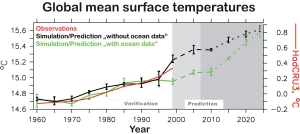Apr 30 2008
To date climate change projections, as published in the last IPCC report, only considered changes in future atmospheric composition. This strategy is appropriate for long-term changes in climate such as predictions for the end of the century.
 Initialised retrospective predictions/forecasts (green) for global mean temperature, compared with observations and predictions not initialised using ocean observations and made using only radiative forcing. Decadal means are shown; error bars indicate the spread of the three ensemble predictions.
Initialised retrospective predictions/forecasts (green) for global mean temperature, compared with observations and predictions not initialised using ocean observations and made using only radiative forcing. Decadal means are shown; error bars indicate the spread of the three ensemble predictions.
However, in order to predict short-term developments over the next decade, models need additional information on natural climate variations, in particular associated with ocean currents. Lack of sufficient data has hampered such predictions in the past. Scientists at IFM-GEOMAR and from the MPI for Meteorology have developed a method to derive ocean currents from measurements of sea surface temperature (SST). The latter are available in good quality and global coverage at least for the past 50 years. With this additional information, natural decadal climate variations, which are superimposed on the long-term anthropogenic warming trend, can be predicted. The improved predictions suggest that global warming will weaken slightly during the following 10 years.
“Just to make things clear: we are not stating that anthropogenic climate change won’t be as bad as previously thought”, explains Prof. Mojib Latif from IFM-GEOMAR. “What we are saying is that on top of the warming trend there is a long-periodic oscillation that will probably lead to a to a lower temperature increase than we would expect from the current trend during the next years”, adds Latif. “That is like driving from the coast to a mountainous area and crossing some hills and valleys before you reach the top”, explains Dr. Johann Jungclaus from the MPI for Meteorology. “In some years trends of both phenomena, the anthropogenic climate change and the natural decadal variation will add leading to a much stronger temperature rise.”
Emmy-Noether1 fellow and lead author Dr. Noel Keenlyside from IFM-GEOMAR continues: “In addition to the greenhouse gas concentrations we are using observed SST’s of the past decades in our climate model simulations, a method which has already successfully been applied for seasonal predictions and El Niño forecasting. The SST’s influence the winds and the heat exchange between ocean and atmosphere, and both factors impact ocean currents. The results are very encouraging and show that at least for some regions around the world, it is possible to predict natural climate oscillations on decadal time scale. Europe and North America are two such regions because they are influenced by the North Atlantic and Tropical Pacific, respectively.”
Decadal climate precitions are not weather forecasts, as Prof. Latif expands upon: “Such forecasts will not enable us to tell you whether or not we will have a white Christmas in 2012 in northern Germany, but we will be able to provide a tendency as to whether or not some decades will be warmer or cooler than average. Of course, always with the assumption that no other unforeseen effects such as volcanic eruptions occur, which can have a substantial effect on our climate as well”, summarizes Prof. Latif.